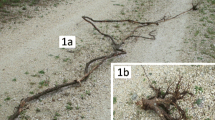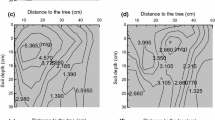Abstract
We applied a fractal root model to the 3D architecture of the coarse root systems of Betula pendula Roth, Picea abies (L.) H. Karst., and Pinus sylvestris L. in mixed boreal forests. Our dataset consisted of 60 root systems excavated in five different mixed forest stands. We analyzed the variability of the model parameters with respect to species, site type, and different root axes. According to our results, the cross-sectional area of root segments (i.e. second power of diameter) was a suitable variable for analyzing the values of parameters of the fractal model. The parameter values varied with generation and order of root segments; the roots thus did not follow the simple fractal branching. The variation of parameters along the root axes showed the existence of a zone of rapid tapering in all tree species. The model was, with parameter values analyzed from the data, moderately capable of accounting for the main coarse root characteristics. It was important for model predictions to take into account the tapering of root segments. We conclude that, in boreal forests, tree root systems are the output of the axis-specific morphogenetic branching rules and functional adaptation to spatial heterogeneity in the soil.









Similar content being viewed by others
References
Berntson GM (1996) Fractal geometry, scaling, and the description of plant root architecture. In: Waisel Y, Eshel A, Kafkafi U (eds) Plant roots—the hidden half, 2nd edn. MDI Dekker, New York, pp 259–272
Cajander AK (1949) Forest types and their significance. Acta For Fenn 56:1–71
Collet C, Löf M, Pagès L (2006) Root system development of oak seedlings analysed using and architectural model. Effects of competition with grass. Plant Soil 279:367–383
Danjon F, Reubens B (2008) Assessing and analyzing 3D architecture of woody root systems, a review of methods and applications in tree and soil stability, resource acquisition and allocation. Plant Soil 303:1–34
Fitter AH (1991) The ecological significance of root system architecture: an economic approach. In: Atkinson D (ed) Plant root growth. An ecological perspective. Blackwell, Oxford, pp 229–243
Fitter AH, Stickland TR (1991) Architectural analysis of plant-root systems 2. Influence of nutrient supply on architecture in contrasting plant-species. New Phytol 118(3):383–389
Fitter AH, Stickland TR, Harvey ML, Wilson GW (1991) Architectural analysis of plant-root systems 1. Architectural correlates of exploitation efficiency. New Phytol 118(3):375–382
Grime JP (2002) Plant strategies, vegetation processes and ecosystem properties, 2nd edn. Wiley, Chichester
Grime JP, Campbell BD, Mackey JML, Crick JC (1991) Root plasticity, nitrogen capture and competitive ability. In: Atkinson D (ed) Plant root growth. An ecological perspective. Blackwell, Oxford, pp 381–397
Jourdan C, Rey H (1997) Modelling and simulation of the architecture and development of the oil-palm (Elaeis guineensis Jacq) root system 1. The model. Plant Soil 190(2):217–233
Kalliokoski T, Nygren P, Sievänen R (2008) Coarse root architecture of three boreal tree species growing in mixed stands. Silva Fenn 42(2):189–210
MacDonald N (1983) Trees and networks in biological models. Wiley, Avon, Chichester
Mandelbrot BB (1983) The fractal geometry of nature. W.H. Freeman, New York
Mayer DG, Butler DG (1993) Statistical validation. Ecol Model 68(1–2):21–32
Nygren P, Miaoer L, Ozier-Lafontaine H (2009) Effects of turnover and internal variability of tree root systems on modelling coarse root architecture: comparing simulations for young Populus deltoides with field data. Can J For Res 39(1):97–108
Ozier-Lafontaine H, Lecompte F, Sillon JF (1999) Fractal analysis of the root architecture of Gliricidia sepium for the spatial prediction of root branching, size and mass: model development and evaluation in agroforestry. Plant Soil 209(2):167–180
Pagès L, Vercambre G, Drouet JL, Lecompte F, Collet C, Le Bot J (2004) Root type: a generic model to depict and analyse the root system architecture. Plant Soil 258(1–2):103–119
Richardson AD, zu Dohna HZ (2005) Predicting root biomass from branching patterns of Douglas-fir root systems. Oikos 108(3):648–648 (vol 100, pg 96, 2003)
Salas E, Ozier-Lafontaine H, Nygren P (2004) A fractal root model applied for estimating the root biomass and architecture in two tropical legume tree species. Ann For Sci 61(4):337–345
Smith DM (2001) Estimation of tree root lengths using fractal branching rules: a comparison with soil coring for Grevillea robusta. Plant Soil 229(2):295–304
Soethe N, Lehmann J, Engels C (2007) Root tapering between branching points should be included in fractal root system analysis. Ecol Model 207(2–4):363–366
Tobin B, Cermak J, Chiatante D, Danjon F, Di Orio A, Dupuy L, Eshel A, Jourdan C, Kalliokoski T, Laiho R, Nadezhdina N, Nicoll B, Pagés L, Sande-Silva J, Spannos I (2007) Towards developmental modelling of tree root systems. Plant Biosyst 141(3):481–501
van Noordwijk M, Mulia R (2002) Functional branch analysis as tool for fractal scaling above- and belowground trees for their additive and non-additive properties. Ecol Model 149(1–2):41–51
van Noordwijk M, Purnomosidhi P (1995) Root architecture in relation to tree-soil-crop interactions and shoot pruning in agroforestry. Agrofor Syst 30:161–173
van Noordwijk M, Spek LY, Dewilligen P (1994) Proximal root diameter as predictor of total root size for fractal branching models. 1. Theory. Plant Soil 164(1):107–117
Zimmermann MH (1983) Xylem structure and the ascent of sap. Springer, Berlin, p 142
Acknowledgments
We gratefully acknowledge the help of Jari Perttunen as he provided the software to read in the architectural data of roots for data analysis. We are grateful to two anonymous reviewers for their useful comments. The study was funded by the Academy of Finland (Project 210875).
Author information
Authors and Affiliations
Corresponding author
Additional information
Communicated by R. Matyssek.
Rights and permissions
About this article
Cite this article
Kalliokoski, T., Sievänen, R. & Nygren, P. Tree roots as self-similar branching structures: axis differentiation and segment tapering in coarse roots of three boreal forest tree species. Trees 24, 219–236 (2010). https://doi.org/10.1007/s00468-009-0393-1
Received:
Revised:
Accepted:
Published:
Issue Date:
DOI: https://doi.org/10.1007/s00468-009-0393-1




